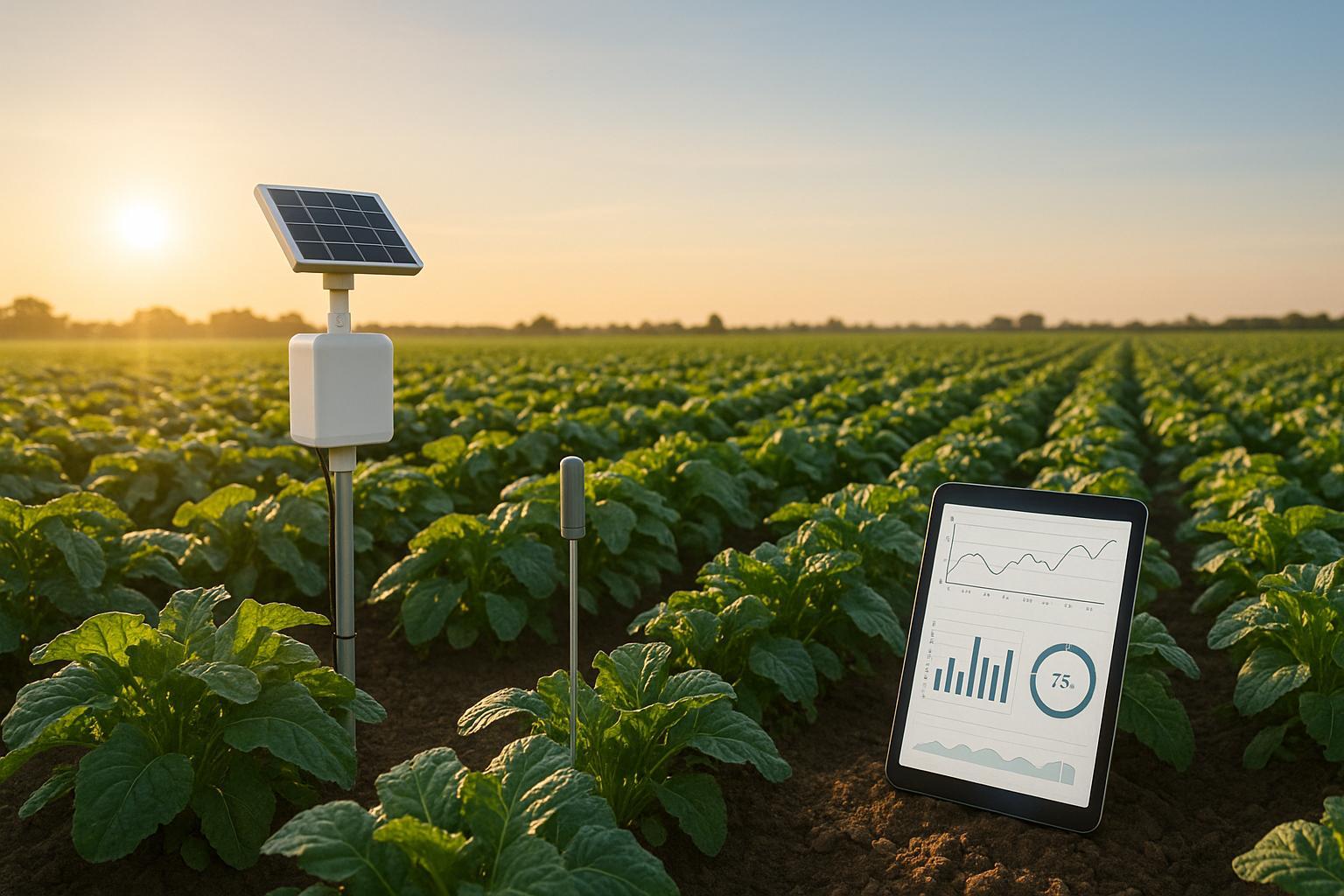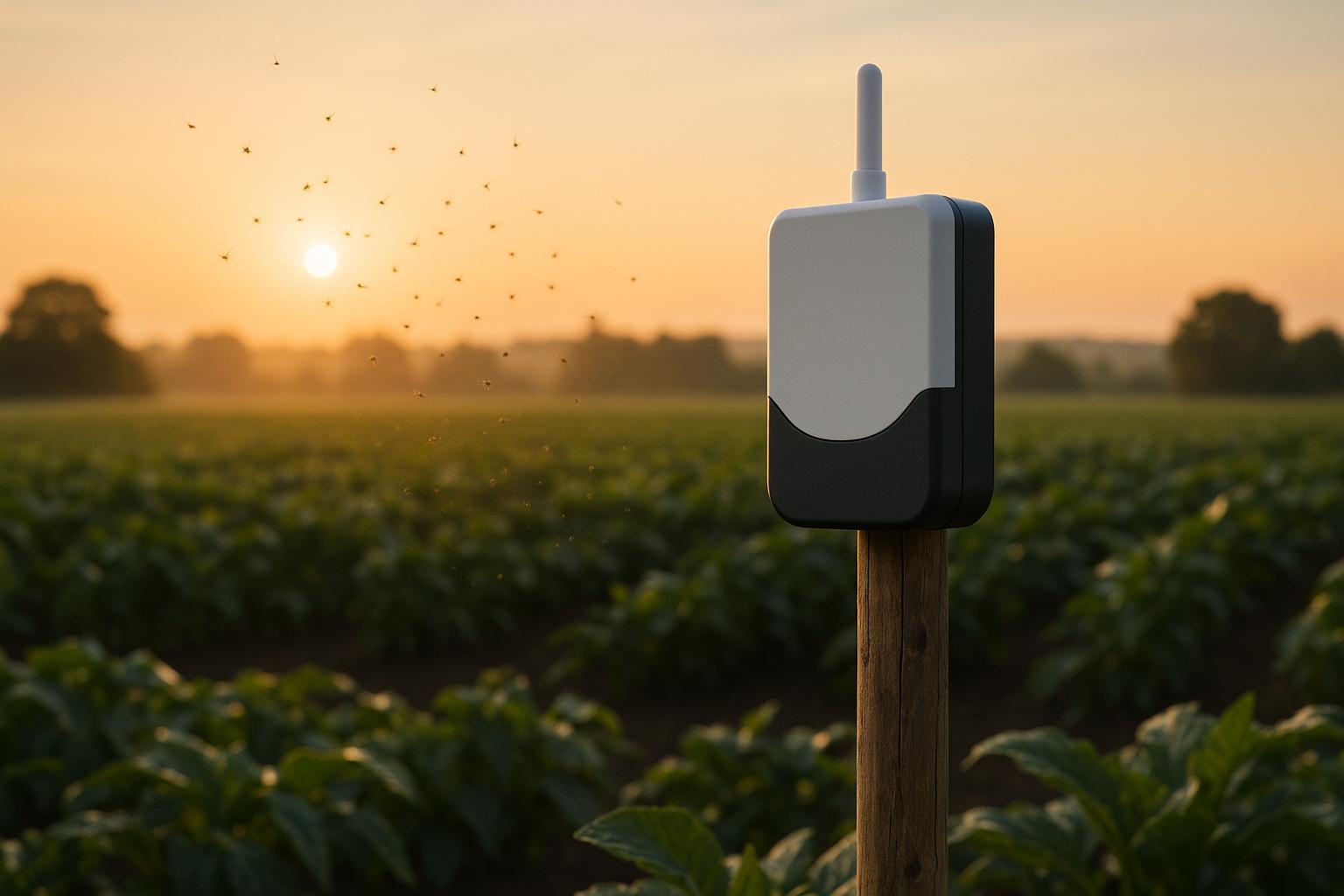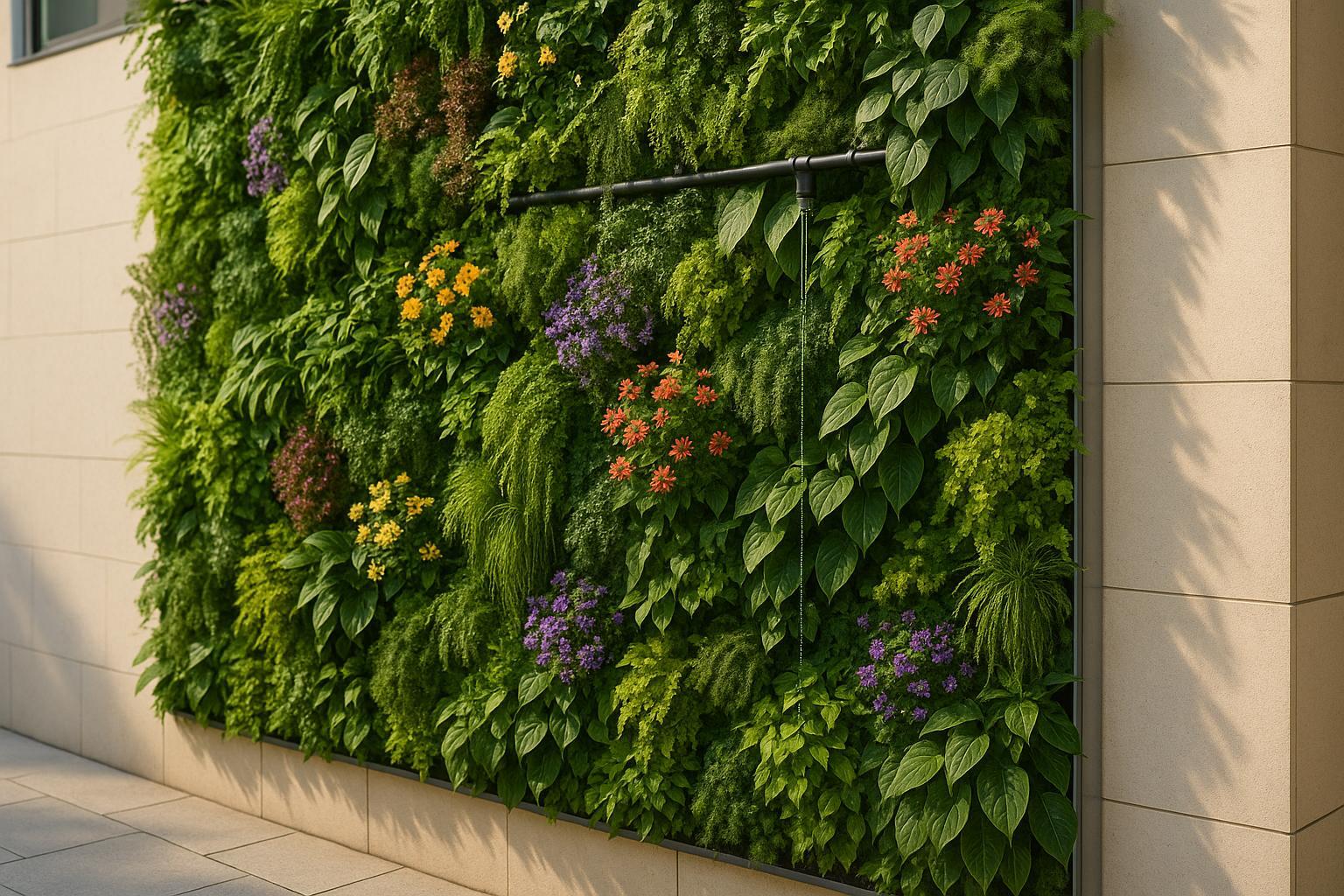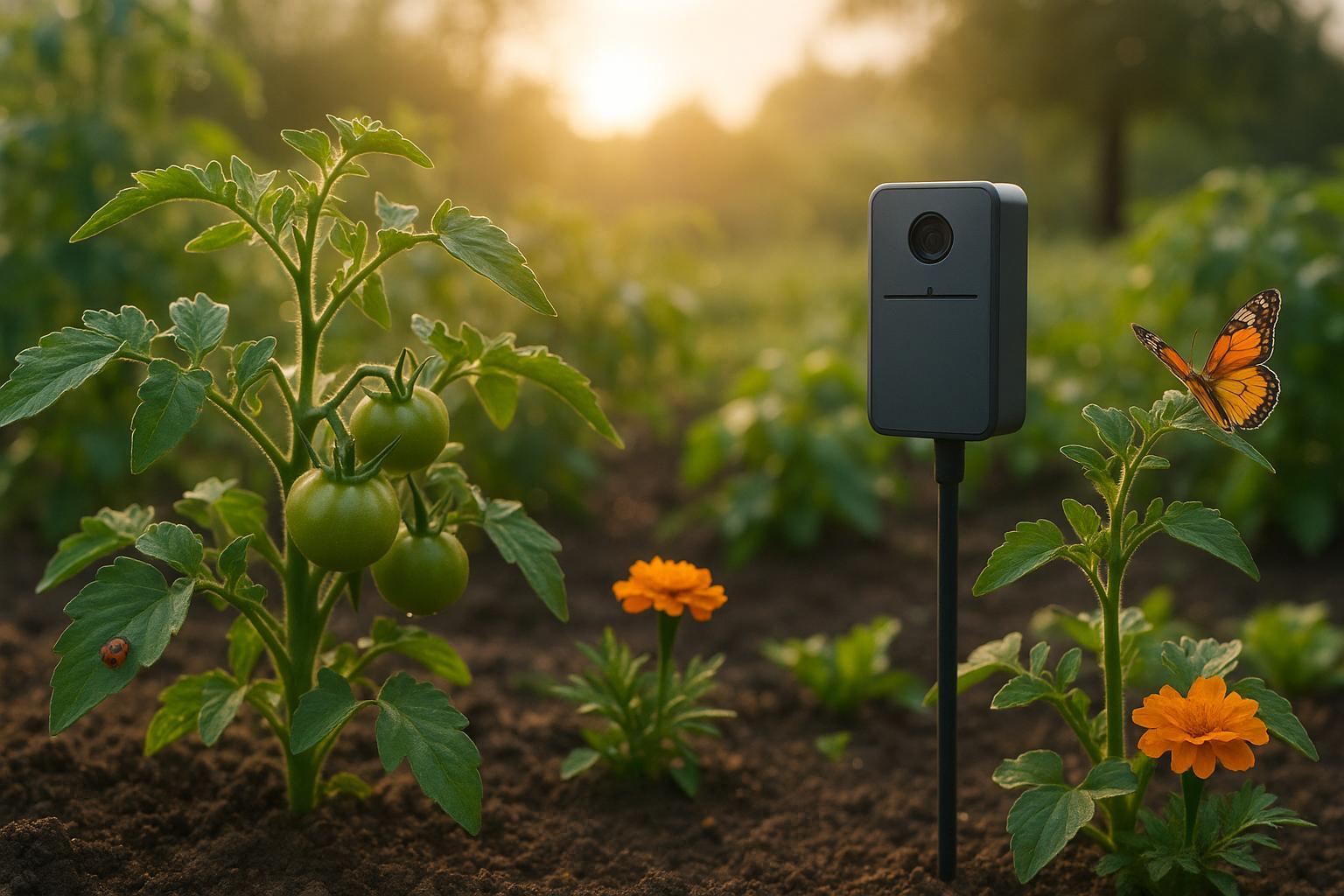Infrared Imaging for AI Plant Stress Detection

Plants show stress before you can see it. Infrared imaging and AI make it possible to detect plant stress early - before visible damage occurs. This technology measures temperature changes in plants, a key indicator of stress caused by heat, drought, or disease. AI analyzes this data with over 80% accuracy, giving you precise, actionable insights.
Key Benefits:
- Early Detection: Spot stress before it’s visible, preventing crop damage.
- Efficiency: AI processes data for 10,000+ acres in under an hour.
- Precision: Pinpoint stressed areas for targeted action like watering or shading.
- Non-Destructive: Monitor plant health without harming them.
Why It Matters:
Heat stress can reduce yields of key crops like maize (-7.4%) and wheat (-6.0%). Early interventions - enabled by infrared imaging and AI - help protect crops, reduce waste, and support global food security.
Whether you’re a farmer managing large fields or a home gardener, this technology ensures healthier plants and smarter decisions.
Arti Singh - AI at the Forefront: Transforming Plant Stress Monitoring in Real Time

How Infrared Imaging Detects Plant Stress
Infrared imaging can spot temperature changes in plants caused by stress before any visible signs appear. Below, we’ll explore how thermal imaging measures stress, supports remote monitoring, and processes data to guide effective decisions.
Measuring Plant Stress Through Heat Detection
Plants naturally release thermal infrared radiation within the 8–14 μm wavelength range, which thermal cameras capture and translate into temperature readings. Healthy plants maintain a balance between absorbing sunlight and releasing heat through transpiration, a process regulated by stomatal conductance. However, when plants experience stress, they close their stomata to conserve water, reducing transpiration and causing leaf temperatures to rise.
These temperature shifts can be quite pronounced. For instance, drought-stricken grape leaves can be nearly 6°C (11°F) warmer, with leaf temperatures sometimes exceeding the surrounding air by as much as 10°C (18°F). A practical example comes from kiwifruit orchards where thermal imaging identified P. syringae pv. actinidiae infections. Infected trees showed significantly higher temperatures, particularly in the outer canopy regions. Such precise data feeds AI models designed to predict and address heat stress.
Non-Destructive Plant Monitoring
Infrared imaging offers a non-invasive way to gather detailed data about plant health. Thermal cameras are incredibly sensitive, capable of detecting temperature differences as small as 0.2°F. These cameras can be mounted on drones to survey vast fields or used as handheld tools for closer inspection, producing real-time temperature maps that highlight stress patterns across growing areas.
By identifying stress early, growers can act quickly to address issues like water shortages, nutrient deficiencies, diseases, or pest problems. This early intervention can prevent long-term damage and preserve crop yields.
Processing Thermal Images
Turning raw thermal images into usable insights requires advanced processing techniques. These images are calibrated, adjusted for environmental factors, and segmented to focus on plant canopies, enabling accurate stress detection using metrics like the Crop Water Stress Index (CWSI). The CWSI compares plant temperatures to ambient conditions to measure stress levels. Research indicates that a CWSI value above 0.36 typically signals plant stress. For example, in a study using drones equipped with thermal cameras to monitor wild tomato plants, the CWSI threshold reliably identified stressed plants, especially during the fruit development and ripening stages.
Processing also integrates vegetation indices like the Green-Red Vegetation Index (GRVI), which separates plant material from soil, ensuring temperature readings are plant-specific.
Modern thermal imaging systems are incredibly advanced. Companies like Ceres Imaging have developed cameras that detect temperature differences as small as 0.2°F. These tools allow for precise stress detection and targeted interventions.
According to Ceres Imaging, "The average Ceres AI conductance measurement from its imagery over the season has provided the best correlation with applied water."
This level of accuracy empowers farmers to focus their efforts where they’re needed most. Instead of treating an entire field uniformly, they can allocate water, nutrients, or other resources precisely to the areas that require attention, optimizing both time and costs.
AI Analysis of Infrared Plant Images
Thermal cameras can capture infrared data, but it's the power of AI algorithms that turns this data into actionable insights about plant health.
AI Methods for Image Analysis
Machine learning techniques, such as Support Vector Machines (SVMs) and Convolutional Neural Networks (CNNs), are particularly effective at identifying temperature patterns in thermal images. These algorithms can classify plants as either stressed or healthy with impressive accuracy. Unlike older methods that often struggle with noisy background data, CNNs can automatically pick out the most important temperature patterns, even in complex thermal scenes where plants, soil, and other environmental factors create intricate temperature variations.
For example, research on purple basil grown in vertical farms showcased the practical application of these AI tools. By using SVMs to analyze thermal images of plants under varying levels of root dehydration stress, researchers achieved high predictive accuracy. Other methods, such as Artificial Neural Networks (ANNs), Random Forest models, Multilayer Perceptron models, and Generative Adversarial Networks (GANs) for data augmentation, also play a role in improving these predictions.
Combining these advanced techniques with data from multiple sources can take stress detection to the next level.
Combining Multiple Data Sources
AI systems are increasingly integrating thermal imaging data with other sensor inputs to provide a more complete view of plant health. This multimodal approach blends data from RGB cameras, thermal imaging, and spectral sensors, capturing a broader range of plant conditions.
One study, for instance, achieved 97.80% classification accuracy by combining Normalized Difference Vegetation Index (NDVI) data with neural networks. IoT integration further enhances these systems by streaming real-time data - such as soil moisture, air temperature, humidity, and plant thermal signatures - into AI models for continuous stress analysis and predictions.
Research on cotton genotypes highlights the value of this approach. When thermal imaging was combined with physiological measurements like water potential and chlorophyll fluorescence, soil moisture emerged as a key factor influencing classification errors. Misclassified plants often showed unusual soil moisture levels or altered photosynthetic efficiency, emphasizing how environmental factors can impact thermal readings.
Explainable AI (XAI) tools add another layer of value by clarifying which variables - like soil moisture or temperature patterns - played the biggest role in a stress detection outcome. This transparency makes it easier to identify problems and implement targeted interventions.
Creating AI Models for Different Plant Types
Building effective AI models for diverse plant species requires careful preparation, including standardized preprocessing and the use of transfer learning. Each plant species has unique thermal characteristics and stress responses, making it challenging to create models that work well across varied conditions. The diversity of the training dataset is critical; limited or biased data can hinder a model's ability to generalize effectively.
Transfer learning offers a practical solution by allowing models trained on one species to adapt to others. This method uses previously learned thermal patterns, reducing the need for large amounts of new data and cutting down on training time.
For example, binary classification models trained on plants experiencing medium to high stress levels have shown reliable results. The BC-3 model, in particular, identified 115 out of 179 stressed plant samples correctly, achieving an accuracy rate of 73.33%. This demonstrates the potential for early and effective stress detection.
Standard preprocessing steps - such as normalization, calibration, and noise reduction - are essential for ensuring consistent results across different sensors and environments. Without these measures, AI models may struggle to maintain accuracy when applied to new plant species or growing conditions.
While the development of these machine learning models demands significant computational power and technical expertise, the payoff is substantial. Accurate stress detection enables timely interventions, helping to protect crops and minimize losses.
🚀 Ready to Reinvent Your Garden?
Join thousands of homeowners who have transformed their gardens using our AI design tool. Upload one photo to explore endless possibilities.
Get your AI garden designs →Real-World Applications and Case Studies
Infrared imaging combined with AI is reshaping how we care for plants, bringing precision and data-driven solutions to both large-scale agriculture and home gardening.
Agricultural Success Stories
Commercial farming has embraced infrared imaging and AI to achieve measurable results. For example, Farmonaut’s satellite-based system provides crop health data with over 90% accuracy, covering large areas without the expense or maintenance of drones.
Ceres AI uses thermal imaging to optimize irrigation by measuring plant conductance with precision. As one customer shared:
"The average Ceres AI conductance measurement from its imagery over the season has provided the best correlation with applied water."
This technology not only delivers detailed insights but also reduces costs compared to traditional soil moisture probes.
In India, the World Economic Forum's AI4AI initiative significantly improved chili farming. Yields increased by 21%, pesticide use dropped by 9%, fertilizer use by 5%, and unit prices rose by 8%. Similarly, AgroScout in Israel uses aerial thermal data to improve harvest timing, boosting efficiency by 10%.
Benefits for Home Gardeners
These cutting-edge tools are no longer limited to large farms. Home gardeners now have access to professional-grade insights through user-friendly apps. Disease identification apps powered by AI can detect plant diseases with up to 98% accuracy, often spotting issues before symptoms are visible. Advanced garden management platforms integrate thermal imaging with data from soil sensors, weather stations, and more, offering comprehensive health assessments. These systems can reduce disease outbreaks by up to 60% through timely alerts, often warning gardeners 3–5 days before pathogens take hold.
AIGardenPlanner takes this a step further by using AI to design microclimates that minimize plant stress. By combining local climate data with thermal imaging, it provides personalized recommendations for plant placement and care, helping gardeners prevent problems before they arise.
Smart irrigation systems are another game-changer. They adjust watering schedules in real-time based on thermal and environmental data, ensuring plants get just the right amount of moisture while minimizing waste. Micro-climate monitors also track specific garden conditions, offering tailored alerts that help gardeners shift from reactive to proactive care.
Supporting Climate-Smart Gardening
These technologies not only improve plant health but also promote sustainable gardening practices. Infrared imaging and AI make resource use more efficient, reducing environmental impact. For example, Microsoft’s FarmVibes project uses smart water management to predict shortages, allowing gardeners and farmers to prepare by collecting and storing water in advance.
Thermal imaging precision also enables targeted fertilizer application, reducing chemical use while maintaining plant health. A Ceres AI user explained:
"With Ceres AI we can take a more targeted approach to applying fertilizer and nutrients."
Globally, AI and precision agriculture are expected to cut annual operating costs by over 22% and reduce ammonia emissions by 38%. These savings come from using fertilizers, water, and other inputs more efficiently, guided by precise monitoring.
Cainthus’s computer vision AI solution showcases how these technologies extend beyond plants. In 2024, their system improved feed efficiency in livestock operations by 4% and reduced low feed hours by 43%. While focused on animal agriculture, it demonstrates how AI can optimize resources while maintaining productivity.
Finally, AI-powered predictive models can forecast extreme weather events and their impact on plants. This allows farmers and gardeners to take protective measures in advance, reducing crop losses and enhancing resilience in an increasingly unpredictable climate. Such tools are vital for ensuring food security as climate challenges grow.
sbb-itb-4d6a8dd
Benefits, Challenges, and Future Research
Infrared imaging combined with AI is reshaping how we care for plants, offering new ways to detect stress early and monitor crops efficiently. Building on the mechanisms and AI integration discussed earlier, let’s explore the benefits, challenges, and future possibilities of this technology.
Benefits of Infrared Imaging and AI
This technology has transformed plant health monitoring in several impactful ways. Thermal imaging allows for non-destructive monitoring, meaning plants can be studied without any harm. AI-powered models take this further, achieving over 80% accuracy in detecting early signs of crop stress. This early detection can prevent yield losses of up to 30%.
AI also brings unmatched speed and efficiency. For example, machine learning algorithms can analyze satellite images covering more than 10,000 acres in less than an hour. It provides consistent and unbiased results, unlike traditional methods prone to human error. Plus, integrating AI with imaging sensors has led to reduced pesticide use, better crop productivity, and a positive impact on global food security.
| Benefit | Traditional Methods | AI + Infrared Imaging |
|---|---|---|
| Detection Speed | Days to weeks | Under 1 hour for 10,000+ acres |
| Accuracy | Subjective, variable | Over 80% consistent accuracy |
| Plant Impact | Often destructive | Completely non-destructive |
| Cost Efficiency | High labor costs | Lower per-acre monitoring costs |
| Environmental Impact | Higher chemical use | Reduced pesticide application |
Current Challenges and Limitations
Despite its advantages, the technology isn’t without hurdles. One of the biggest challenges is processing the enormous amounts of data generated by thermal imaging systems. Advanced data processing capabilities are needed to make sense of this information.
Environmental variability adds another layer of complexity. For instance, a thermal reading that signals stress in one environment might be perfectly normal in another, making it tricky to standardize interpretations. Training AI models also becomes challenging with limited or biased datasets.
Cost is another barrier. High-quality imaging tools like hyperspectral cameras, thermal sensors, and LiDAR equipment come with hefty price tags. For smaller operations or research projects, these costs can be prohibitive. Even RGB sensors, which are more affordable, often lack the detailed spectral data needed for comprehensive stress analysis.
Geographic and crop diversity further complicate things. Different climates, weather conditions, and crop types make it difficult for AI models to generalize across regions. Additionally, limited digital literacy, uneven smartphone access in rural areas, and concerns about data privacy hinder widespread adoption.
Future Advances in Plant Stress Detection
Overcoming these challenges opens the door to exciting advancements in plant stress detection. A key focus is improving model accuracy. Researchers are working to refine machine learning models so they can deliver reliable results across diverse crops, regions, and environmental conditions.
Cost reduction and scalability are also priorities. AI-powered analysis and cloud solutions are expected to make precision monitoring more affordable, even for smaller farms and home gardeners. As mobile and data infrastructure improves, more farmers in remote areas will gain access to these tools.
The integration of IoT (Internet of Things) is another promising development. By connecting millions of sensors and devices, farmers could monitor crop health continuously. Combining AI with IoT allows for fully automated systems, while edge AI - embedding AI into field sensors - enables real-time, on-site data analysis without relying on constant cloud connectivity. The rollout of 5G networks will further enhance these capabilities.
Multimodal approaches are also gaining traction. By blending thermography with RGB imaging or multi- and hyperspectral imaging, researchers can address the limitations of thermal imaging. Additionally, the rise of explainable AI is helping build trust among users. Farmers increasingly demand clear, actionable insights, and transparent AI models are designed to meet these expectations.
These advancements promise to make infrared imaging and AI even more effective and accessible, benefiting everything from large-scale agriculture to home gardening tools like AIGardenPlanner. The future of plant stress detection is undoubtedly bright, with solutions that cater to both high-tech farms and everyday gardeners alike.
Conclusion: The Future of AI-Driven Gardening
Key Points
Infrared imaging combined with AI is changing how we detect plant stress, enabling quicker and more precise interventions to maintain healthier crops. AI tools can identify early signs of stress with impressive accuracy, and machine learning algorithms can process satellite imagery of over 10,000 acres in less than an hour. This kind of early detection allows for timely action, which can make all the difference in crop health.
AI’s ability to deliver fast, consistent analysis minimizes human error and provides actionable insights. Tools like See & Spray are also paving the way for more efficient farming by cutting down on chemical usage.
How AIGardenPlanner Fits In

Platforms like AIGardenPlanner are taking these advancements and making them accessible to everyday gardeners. By incorporating state-of-the-art technologies, AIGardenPlanner is poised to bring professional-grade plant health monitoring into home gardens. Its AI-powered design tools and tailored plant recommendations provide a strong base for integrating advanced features like thermal imaging and stress detection.
Imagine uploading a photo of your garden to AIGardenPlanner - not just for layout ideas but also for an instant health check. The platform could use thermal imaging to pinpoint stressed plants, suggest targeted solutions, and adapt its recommendations to match your garden's current conditions. With a library of over 50 garden styles and location-specific plant suggestions, AIGardenPlanner has the potential to evolve into a full-scale garden health management system.
This technology isn’t just for hobbyists. Professional landscapers using AIGardenPlanner could offer clients ongoing plant health monitoring, turning one-time garden designs into long-term service opportunities.
Whether you're tending a sprawling field or a small backyard, these tools provide reliable, actionable insights to help you succeed.
Looking Ahead
AI-driven monitoring is set to become a cornerstone of gardening practices everywhere. The AI in agriculture market is projected to grow from $1.7 billion in 2023 to $4.7 billion by 2028, signaling a wave of innovation and investment. With advancements in edge AI, models will soon be built directly into sensors for instant on-site analysis, eliminating the need for constant cloud connectivity. The rollout of 5G networks will further enhance real-time monitoring, making these tools more accessible for everyone - from large-scale farmers to weekend gardeners.
For both home gardeners and landscaping professionals, staying informed about these technologies opens up opportunities for healthier, more productive outdoor spaces. As these tools become easier to use and more affordable, precision gardening techniques - once reserved for large farms - will be available to all.
The future of gardening is smarter and more responsive. Whether you’re designing your first flower bed with AIGardenPlanner or managing multiple client landscapes, AI-driven tools are set to become as indispensable as a trowel or pruning shears. The speed at which we adopt these innovations will shape how quickly gardening evolves into a more efficient and sustainable practice.
FAQs
How does infrared imaging help detect plant stress before it becomes visible?
Infrared imaging is a powerful tool for spotting plant stress before it becomes visible. It works by detecting the heat emitted from plant surfaces. When plants face challenges like heat or drought, their leaf temperatures change due to shifts in their physiological processes. These temperature changes are often too subtle for the human eye to notice but can be captured effectively using infrared cameras.
Pairing this technology with AI takes it to the next level. AI can analyze thermal data, uncover patterns, predict stress conditions, and offer actionable insights. This non-invasive approach enables early detection and timely intervention, helping plants remain healthy and flourish.
What challenges exist in using AI and infrared imaging to detect plant stress?
🎨 Visualize Your Dream Garden Today!
Transform any outdoor space into a professional landscape design in minutes. Just upload a photo, choose your style, and let our AI do the rest.
Start your garden transformation now →Challenges in Detecting Plant Stress with AI and Infrared Imaging
Using AI and infrared imaging to identify plant stress isn't without its obstacles. One of the biggest issues is the limited availability of diverse, high-quality datasets. For AI models to work effectively, they need data that covers a wide range of farm types, climates, and conditions. Without this variety, the models risk becoming biased, making them unreliable in different agricultural environments.
Another challenge is the cost of adopting AI technology. Smaller farms and those in less developed areas often struggle with the financial burden of upgrading infrastructure and providing the necessary training. On top of that, data privacy concerns, compatibility with existing systems, and the lack of transparency in some AI tools make the process even more complicated.
Overcoming these hurdles will take a collective effort. Improving data collection methods, lowering technology costs, and ensuring that AI tools are accessible to farmers of all scales are essential steps toward making these solutions practical and effective for everyone.
How can AI and infrared imaging help home gardeners improve plant health?
How AI and Infrared Imaging Can Transform Home Gardening
AI and infrared imaging are changing the way home gardeners care for their plants, offering tools to detect problems before they become visible. Infrared imaging works by identifying temperature changes in plants, which can hint at issues like water stress or early signs of disease. This early detection gives gardeners the chance to address problems before they escalate.
What makes this even more powerful is the role of AI. By analyzing the data collected from infrared imaging, AI can suggest specific actions, like adjusting watering schedules or tweaking nutrient levels. These insights help gardeners keep their plants healthier, boost their harvests, and embrace gardening methods that are kinder to the environment.
Related posts
Related Articles

AI vs IoT: Which Drives Better Plant Growth Predictions?
Explore how AI and IoT are revolutionizing agriculture by enhancing plant growth predictions through real-time data and advanced analytics.

IoT Sensors for Pest Monitoring: Real-Time Data Explained
Explore how IoT sensors are revolutionizing pest monitoring in agriculture, providing real-time data for smarter, eco-friendly pest control.

AI Scheduling for Vertical Gardens
Explore how AI scheduling enhances vertical gardening by optimizing irrigation, improving plant health, and conserving resources.

AI Pest Control: How Algorithms Detect Threats
Explore how AI is transforming pest control through early detection, eco-friendly solutions, and accessible tools for all gardeners.

The Ultimate Guide to Creating a Vegetable Planter Garden
Learn how to create a vegetable planter garden with this comprehensive guide. Discover the benefits of growing your own vegetables and the steps involved in creating a planter garden.

How AI Tracks Irrigation Performance in Real Time
Explore how AI-driven irrigation systems optimize water usage and enhance crop yields through real-time monitoring and predictive analytics.